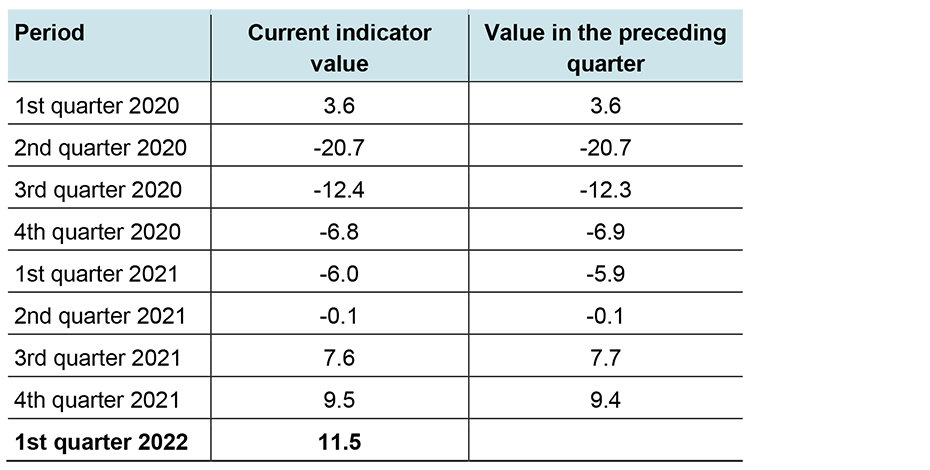KOF Employment Indicator reaches all-time high
The KOF Employment Indicator continues to rise and is at its highest level since 2000. Its further increase is mainly due to manufacturing and the wholesale sector. In the hospitality industry, on the other hand, the employment outlook has deteriorated somewhat.
KOF Employment Indicator (constantly updated)
The KOF Employment Indicator continues to perform well. Having risen sharply to 9.5 points (revised from 9.4) in the fourth quarter of 2021, the indicator has reached 11.5 points in the new year. This is historic: the indicator has never been this high in its current form. The last time the indicator hit a similar level was in the fourth quarter of 2000, although at that time it covered far fewer sectors.
The KOF Employment Indicator is calculated from the quarterly KOF Business Tendency Surveys. The evaluations for the first quarter of 2022 are based on the responses of around 4,500 firms that were asked in January about their employment plans and expectations. On balance, the companies surveyed reckon that their current staffing levels are too low and would like to increase their workforces further in the next three months. The indicator value suggests very strong overall employment growth in the Swiss labour market over the current and coming quarters.
All sectors plan to increase employment; influence of the omicron wave unclear
The survey results give cause for hope that employment trends across all sectors will be encouraging over the coming months. Very high indicator values have been achieved in several sectors from a historical perspective. The employment indicator for the manufacturing and wholesale sectors has performed particularly well in the first quarter. The last time the indicator for manufacturing reached a similarly high level was in 2007. The companies surveyed in the construction industry also expect to see a significant increase in employment: never before has a similarly positive indicator value been recorded for the KOF Employment Indicator for this sector.
The performance of the hospitality industry is slightly less encouraging. Although the hotels and restaurants surveyed continue to view their current staffing levels as too low, these businesses expect to see job cuts over the coming months. The sector-specific indicator value has therefore fallen slightly compared with the previous quarter.
It is unclear what impact the loss of employment due to the currently very high infection rates is having on the indicator. It is possible that the high indicator values in sectors such as wholesaling and manufacturing can sometimes be attributed to the fact that firms are having to recruit more employees in the short term owing to staff absences as a result of them having to quarantine and self-isolate. It is not yet possible to assess the extent to which the responses of the companies that participated in the surveys reflect this search for temporary staff.

Here you can find the press release as Download PDF (PDF, 242 KB).
KOF Employment Indicator
The KOF Employment Indicator is calculated on the basis of the quarterly KOF Business Tendency Surveys. As part of these surveys, KOF asks private businesses in Switzerland to assess their current staffing levels and to state whether they intend to change them over the coming three months. A positive indicator figure means that the number of surveyed companies considering staff cuts in the reference quarter is smaller than the number of companies intending to create jobs. It has been shown in the past that these assessment anticipate actual trends on the labour market.
Click here for more information about the Indicator and its methodology.
Contact
KOF Konjunkturforschungsstelle
Leonhardstrasse 21
8092
Zürich
Switzerland